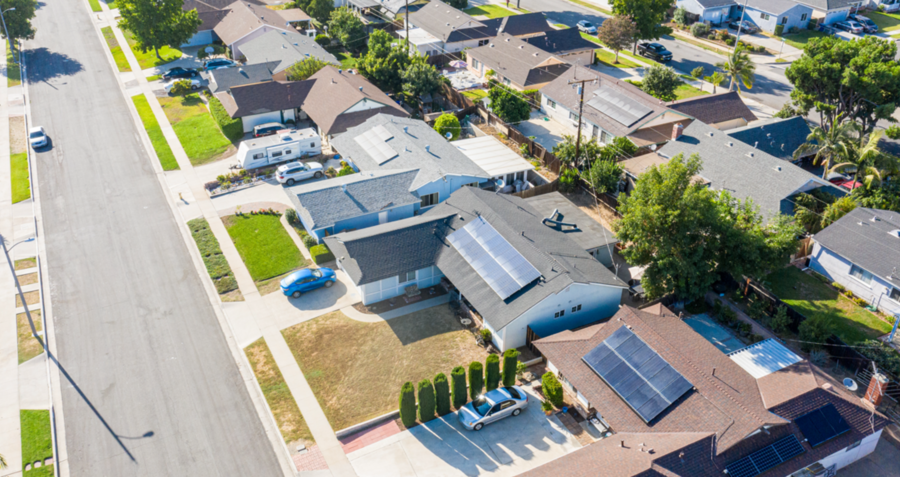You don't need to be an energy boffin to have heard the buzz around the concept of virtual power plants (VPPs). And like anything new and exciting, there are plenty of surprising facts and interesting titbits to learn about this different way of distributing energy.
Learn about EnergyAustralia's PowerResponse Virtual Power Plant
Virtual power plants are made possible by wider megatrends
Virtual power plants, which aggregate independent sources of energy via centrally managed software, have come about because of several megatrends which are changing the way we live.
The global drive for decarbonisation has altered the energy landscape, making solutions that can help harness renewables like solar and wind power more attractive.
The rapid spread of digitalisation has also created new opportunities in the way people are consuming and producing energy.
And the growth of urbanisation, as more and more people shift towards living in cities, has meant there are opportunities to combine sources of power like never before.
These megatrends are all important factors that have created the perfect environment for the rise of virtual power plants.[1]
VPPs are a complement to demand response
Demand response is the practice of offering consumers an incentive to cut their power use during times of peak demand.
It's a cheap and efficient way to support the grid – instead of adding in more supply, you reduce power generation demand. EnergyAustralia makes use of demand response through its PowerResponse program.
Virtual power plants can be a handy complement to demand response programs. When energy use reaches a peak, combining a demand response program to reduce usage with a virtual power plant event that can send more energy into the grid can really help to stabilise the electricity grid and reduce strain on the system
VPPs and weather forecasts go hand-in-hand
Virtual power plants are as handy as sunscreen or a raincoat for protecting us against severe weather. Renewable energy is heavily dependent on the day's forecast – a cloudy or windless day can cause fluctuations in the availability of solar and wind energy.
As more renewable energy flows into the National Energy Market (NEM), a virtual power plant can help make hay while the sun shines – or the wind blows – by storing the energy across many decentralised batteries, and then aggregating that power for later use.
VPPs are also a vital asset in another weather-related event – heat waves. Extremely hot days cause electricity usage to rise markedly as air conditioners switch on. A VPP can be called on during a heatwave to add extra energy to the grid and keep us cool.
Virtual power plants combine cutting-edge technologies
Virtual power plants have been made possible by digitisation, and they make use of cutting-edge types of tech.
The Internet of Things (IoT), where everyday objects can be connected to the Internet and “talk” to one another, underpins the working model of a VPP.
Artificial intelligence and machine learning technology further enhance the effectiveness of a virtual power plant, helping it to monitor and regulate the flow of power and predict future energy patterns.
Adding this sophisticated software to Australia's National Energy Market (NEM) is an exciting development in the future of energy.
VPPs may one day use blockchain, like cryptocurrency
Speaking of cutting-edge technology, some analysts predict that in the future virtual power plants could count on feed-in from blockchain – the same technology used by cryptocurrency.[2]
Blockchain is a type of database that stores information in a specific, decentralised manner. In the future, it could be harnessed for peer-to-peer energy trading, in a similar way to how cryptocurrency is traded now.
It's not just solar batteries you can use for a VPP
While many VPPs harness the power of household solar and battery systems, like our PowerResponse Virtual Power Plant, they're not the only power sources that can be pooled.
If electric vehicle (EV) growth continues, the energy stored in EV batteries could be connected to the grid using a bi-directional charger and accessed during times of peak demand.
Smart thermostats can also collaborate much as a virtual power plant does by joining together to control energy on the demand response side and lowering power use by adjusting many household thermostats in sync.
VPPs may make energy generation more resilient
Because virtual power plants are decentralised storage systems, they have the potential to be more resilient than centralised ones.
If there's a natural disaster or incident at a power plant, this whole source of power could be removed from the grid, leading to widespread outages.
By contrast, an incident that impacts one battery in a system of thousands won't have anywhere near the same impact, making the solar system more durable.
Australia has the world's largest Virtual Power Plant
With its year-round sunny weather, it's no wonder that Australia has added another ‘big thing' to its collection – the world's largest virtual power plant.
South Australia is the proud owner of the world's largest VPP, with plans to connect a network of 50,000 solars and Tesla Powerwall home battery systems to work together as a single power plant.
You could make a return by joining a VPP
Subsidies for the solar feed-in tariff (FiTs) have been declining over time. This is because many households and businesses now have rooftop solar, so there's more solar-generated energy going back into the grid.
This has reduced the wholesale price of energy flowing through to the grid during the day when the sun is out, and FiTs are being adjusted to reflect the value of solar generation more accurately.
If you've invested in a solar and battery system, joining a virtual power plant program could be a way to make more money from your investment.
Check out our PowerResponse Virtual Power Plant program to learn how you could earn a monthly income from your solar and battery – even if we don't access the energy in your system!




